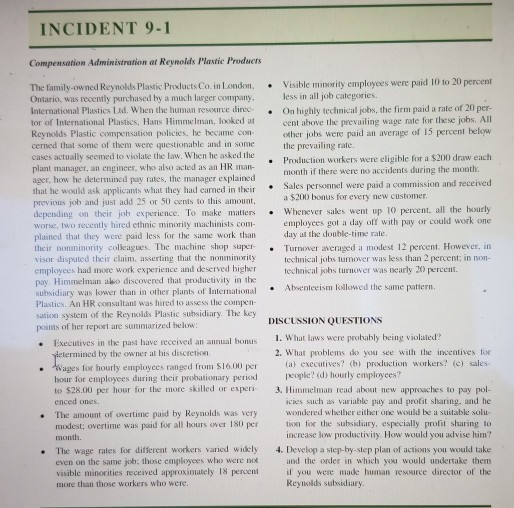Answered step by step
Verified Expert Solution
Question
1 Approved Answer
Compensation Administration at Reynolds Plastic Products . The family-owned Reynolds Plastic Products Co. in London, Ontario, was recently purchased by a much larger company. International


Compensation Administration at Reynolds Plastic Products . The family-owned Reynolds Plastic Products Co. in London, Ontario, was recently purchased by a much larger company. International Plastics Ltd. When the human resource direc- tor of International Plastics. Hans Himmelman, looked at Reynolds Plastic compensation policies, he became con cerned that some of them were questionable and in some cases actually seemed to violate the law. When he asked the plant manager, an engineer, who also acted as an HR man- ager, how he determined pay rates, the manager explained that he would ask applicants what they had camed in their previous job and just add 25 or 50 cents to this amount depending on their job experience. To make matters worse, two recently hired ethnic minority machinist com- plained that they were paid less for the same work than their nonminority colleagues. The machine shop super- Visor disputed their claim, asserting that the nonminority employees had more work experience and deserved higher pay. Himmelman alvo discovered that productivity in the subsidiary was lower than in other plants of International Plastics. An HR consultant was hired to assess the compen sation system of the Reynolds Plastic subsidiary. The key points of her report are summarized below: Executives in the past have received an annual bonus determined by the owner at his discretion Wages for hourly employees ranged from $16,00 per hour for employees during their probationary period to $28.00 per hour for the more skilled or experi enced ones. The amount of overtime paid by Reynolds was very modest; overtime was paid for all hours over 180 per month The wage rates for different workers varied widely even on the same job; those employees who were not visible minorities received approximately 18 percent more than those workers who were Visible minority employees were paid 10 to 20 percent less in all job categories . On highly technical jobs, the firm paid a rate of 20 per- cent above the prevailing wage rate for these jobs. All other jobs were paid an average of 15 percent below the prevailing rate Production workers were eligible for a $200 draw each month if there were no accidents during the month Sales personnel were paid a commission and received a $200 bonus for every new customer Whenever sales went up 10 percent, all the hourly employees got a day off with pay or could work one day at the double-time rate Turnover averaged a modest 12 percent. However, in technical jobs turnover was less than 2 percent; in non Technical jobs turnover was nearly 20 percent. Absenteeism followed the same patter. . . . DISCUSSION QUESTIONS 1. What laws were probably being violated? 2. What problems do you see with the incentives for (a) executives? (b) production workers? (c) sales- people? (d) hourly employees! 3. Himmelman read about new approaches to pay pol- icies such as variable pay and profit sharing, and he wondered whether either one would be a suitable solu- tion for the subsidiary, especially profit sharing to increase low productivity. How would you advise him? 4. Develop a step by step plan of actions you would take and the order in which you would undertake them if you were made human resource director of the Reynolds subsidiary . . Compensation Administration at Reynolds Plastic Products . The family-owned Reynolds Plastic Products Co. in London, Ontario, was recently purchased by a much larger company. International Plastics Ltd. When the human resource direc- tor of International Plastics. Hans Himmelman, looked at Reynolds Plastic compensation policies, he became con cerned that some of them were questionable and in some cases actually seemed to violate the law. When he asked the plant manager, an engineer, who also acted as an HR man- ager, how he determined pay rates, the manager explained that he would ask applicants what they had camed in their previous job and just add 25 or 50 cents to this amount depending on their job experience. To make matters worse, two recently hired ethnic minority machinist com- plained that they were paid less for the same work than their nonminority colleagues. The machine shop super- Visor disputed their claim, asserting that the nonminority employees had more work experience and deserved higher pay. Himmelman alvo discovered that productivity in the subsidiary was lower than in other plants of International Plastics. An HR consultant was hired to assess the compen sation system of the Reynolds Plastic subsidiary. The key points of her report are summarized below: Executives in the past have received an annual bonus determined by the owner at his discretion Wages for hourly employees ranged from $16,00 per hour for employees during their probationary period to $28.00 per hour for the more skilled or experi enced ones. The amount of overtime paid by Reynolds was very modest; overtime was paid for all hours over 180 per month The wage rates for different workers varied widely even on the same job; those employees who were not visible minorities received approximately 18 percent more than those workers who were Visible minority employees were paid 10 to 20 percent less in all job categories . On highly technical jobs, the firm paid a rate of 20 per- cent above the prevailing wage rate for these jobs. All other jobs were paid an average of 15 percent below the prevailing rate Production workers were eligible for a $200 draw each month if there were no accidents during the month Sales personnel were paid a commission and received a $200 bonus for every new customer Whenever sales went up 10 percent, all the hourly employees got a day off with pay or could work one day at the double-time rate Turnover averaged a modest 12 percent. However, in technical jobs turnover was less than 2 percent; in non Technical jobs turnover was nearly 20 percent. Absenteeism followed the same patter. . . . DISCUSSION QUESTIONS 1. What laws were probably being violated? 2. What problems do you see with the incentives for (a) executives? (b) production workers? (c) sales- people? (d) hourly employees! 3. Himmelman read about new approaches to pay pol- icies such as variable pay and profit sharing, and he wondered whether either one would be a suitable solu- tion for the subsidiary, especially profit sharing to increase low productivity. How would you advise him? 4. Develop a step by step plan of actions you would take and the order in which you would undertake them if you were made human resource director of the Reynolds subsidiary
Step by Step Solution
There are 3 Steps involved in it
Step: 1

Get Instant Access to Expert-Tailored Solutions
See step-by-step solutions with expert insights and AI powered tools for academic success
Step: 2

Step: 3

Ace Your Homework with AI
Get the answers you need in no time with our AI-driven, step-by-step assistance
Get Started


